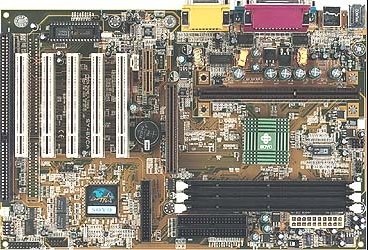
|
Soyo has been one of the most well known motherboard manufacturers around the world for quite sometime now. In the last few years Soyo's boards have build up a good reputation for their overclocking capabilities. With the introduction of the Via Apollo Pro 133A chipset, pretty much every motherboard manufacturer out there began to release their own motherboards based on this chipset. In this review we will be taking a look at the Soyo 6VCA which is based on the Via Apollo Pro 133A.
75% Rating: 
|
|
|
|
Home >
Reviews >
Motherboards >
Soyo 6VCA |
|
|
Soyo 6VCA VIA Apollo 133A
Motherboard Review

Soyo has been one of the most well known motherboard manufacturers
around the world for quite sometime now. In the last few years Soyo's boards
have build up a good reputation for their overclocking capabilities. With the
introduction of the Via Apollo Pro 133A chipset, pretty much every motherboard
manufacturer out there began to release their own motherboards based on this
chipset. In this review we will be taking a look at the Soyo 6VCA which is based
on the Via Apollo Pro 133A.
This board offers AGP 4X, official support of 133MHz bus speed, option for 4
USB ports, ATA 66 support and integrated AC97 audio. On top of this, Soyo has
included quite a number of tweaks/features like suspend to RAM, manual voltage
adjustment and a decent software bundle.
The board is
fitted with 1 AGP slot, 4 PCI slots, 1 PCI/ISA slot and 1 AMR slot. Though AMR
devices are not yet readily available, Soyo made the efforts of including it to
ensure the 6VCA to be future proof. We really liked the overall quality of the
board: it is equipped with good quality Slot 1 brackets and a green heatsink over the chipset.
The heatsink is attached to the chipset with thermal compound and not with a
spring clip, this way heat dissipation is greater as thermal compounds do
exhibit better heat absorption and transfer.
Though a
heatsink on the chipset itself is really not necessary, Soyo decided to play it
safe. To further cleanse signal strength, the board is equipped with 6 1500µF
and 8 1000µF capacitors.
The
layout of the board is a bit strange because it can cause a few small
(practical) difficulties. First of all the AGP slot is less than a centimeter
below the memory banks. So if the installed AGP video card is longer than the
AGP socket (very common), it's impossible to remove any memory modules without
having to remove the AGP display adapter first. In addition, if someone uses the
AMR socket (which I doubt anyone will in the near future) one will not be able
to access the 1st PCI slot easily.
Another issue is
that due to the large size of the board, there is a chance in small ATX cases
that the 3rd DIMM memory bank will prevent users from installing their CD ROM in
the lower 5.25 slot. Last but not least, the floppy connector is located below
the AGP socket, which means that the floppy cable may not be long enough to
reach the floppy connector easily in some very large sized ATX cases.
On
the plus side, a big motherboard like this does allow a user to install a CPU
heatsink without regards to size and this is a definite plus for any hard core
overclocker. In the past, we have seen quite a number of motherboards which (due
to size or layout restrictions) do not allow for a very large heatsink to be
installed. The 6VCA does eliminate this restriction. Soyo's 6VCA comes with the
full (but a bit old) versions of the following programs: Norton Antivirus,
Norton Ghost, Norton Virtual drive. Norton Ghost is a wonderful application that
allows backing up, restoring and copying hard disk partitions.
All in all
we did appreciate the quality of components incorporated into the Soyo 6VCA.
However, we firmly believe that improvements could have been made to the board's
cumbersome layout.
Installation
With no jumpers to be set, the installation of the 6VCA was
pretty easy. Windows 98 installation also went smoothly. VIA's 4 in 1 driver
pack along with AC97 audio drivers were installed without a hitch.
Unfortunately, the included manual only points out features, sockets, and
jumpers of the board. Detailed installation / setup instructions would certainly
have been a plus, especially for a newbie. Soyo has included a full version of
the manual on their CD in order to reduce the cost of supplying a complete
printed manual.
Test Bed
OEM Intel Celeron 566A FC PGA
Retail Intel Celeron 400MHz
PPGA
Tested boards based on the Intel BX chipset: DFI P2XBL, DFI
CB61, Soyo 6BA+IV
Tested boards based on the Via Apollo 133: DFI
CA61
Tested boards based on the Via Apollo Pro 133A: DFI TA64 B,
Soyo 7VCA and Soyo 6VCA
Tested boards based on the Intel 810E
chipset: DFI CW35E
128MB PC 100 CAS 3 SDRAM
3dfx Voodoo3 3000
AGP
Western Digital 13000R ATA 66 Hard Drive
Orchid Nusound 3D (Aureal
Vortex 1) Sound Card
Sony CDU 611 24x CD ROM Drive
Our software
setup consisted of...
Operating system: Windows 98 First
Edition, English
Busmastering drivers: Default Win98 ATA Bus
mastering for Intel BX based boards, VIA 4 in 1 4.19 drivers for all Via chipset
based boards, Intel 810 latest drivers for the CW35E
Video drivers:
3DFX 1.04.00, default driver settings, Vsync disabled, Quake 3 scores were taken
with latest Metabyte Wicked3D MiniGL driver
Sound drivers: Latest
Aureal Vortex 1 drivers
BIOS: Latest MIOS for every motherboard, all
settings were optimized for best performance
Quake3 options: Normal
Graphics quality, low sound quality and all the other default options, demo001
benchmarked at 640x480
|

